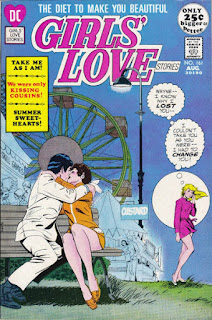We begin this issue with Batman in "Legend of the Key Hook Lighthouse" by Denny O'Neil, Irv Novick, and Dick Giordano. Batman has followed a mob of gun-runners, who are providing weapons for a dictator, but one of the members of the gang decides to help Batman capture the war criminal in exchange for protection. Batman agrees and he is taken to a nearby lighthouse, where the exchange is supposed to take place.
When General Ruizo and his men arrive, Batman takes them by surprise and finds a way to round up Ruizo's henchmen, but the General manages to escape. Batman is able to follow the General on his boat and witnesses how the army man is struck by the light coming from the lighthouse and driven mad by a supernatural presence.
When Batman investigates the lighthouse, he is unable to find any evidence of anybody activating the light and he suspects that he has been helped by a powerful entity. Reprinted in Showcase Presents: Batman Vol. 6 TPB (2016).
The backup is Batgirl in "Invitation to Murder" by Frank Robbins and Don Heck. On the night of the anniversary of their first meeting, Jason Bard takes Barbara Gordon to go see the play "Invitation to Murder." The two are shocked to find that they are the only two people in the audience. When spotting a rifle set to shoot one of the actors, Jason stops the gunman but is knocked out. Changing into Batgirl in the darkness, Barbara tries to stop the shooter but the gunman still manages to get away. Changing back into her civilian guise, Babs checks on Jason and finds that he is all right.
Realizing that the wild shot must have hit somebody, they find that it winged Robbie Marlow who was viewing the play with his wife Tiz (both are referred to as the "Royal Couple" of Hollywood.) After questioning the couple they find out that they were given the tickets to a sold-out showing of the play by an anonymous admirer, and the only reason why Jason and Barbara happened to be there is because of a mix-up with the date they were going to see the show. Finding it all suspicious, Babs tells Jason to keep an eye on the couple while she goes to "call the police". This story continues next issue and was reprinted in Showcase Presents: Batgirl Vol. 1 TPB (2007) and Batgirl: The Bronze Age Omnibus Vol. 1 HC (2018).
The reprints begin with "The Australian Code Mystery" by David V. Reed, Alex Toth, and Sy Barry and reprinted from World's Finest Comics #66 (1953).
We end with "Private Eye of Venus" by Gardner Fox and Carmine Infantino and reprinted from Strange Adventures #83 (1957).
Edited by Julius Schwartz.




































